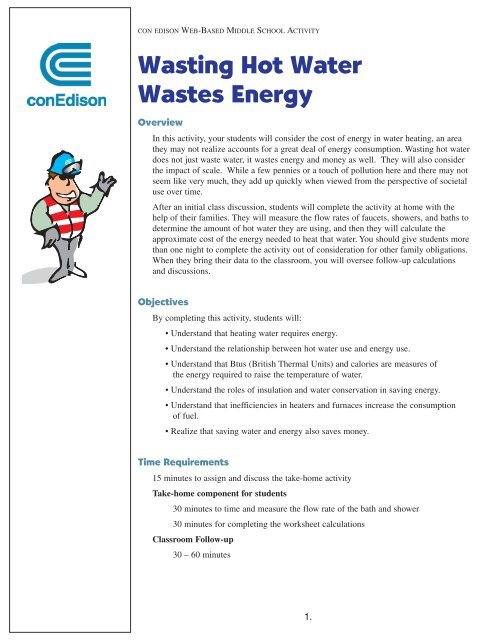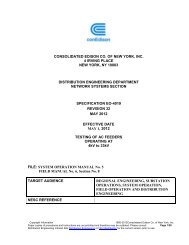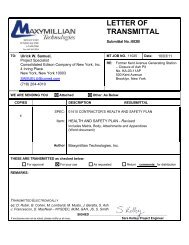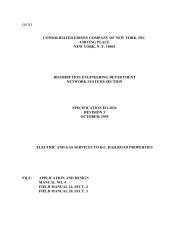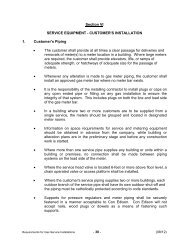Wasting Hot Water Wastes Energy - Con Edison
Wasting Hot Water Wastes Energy - Con Edison
Wasting Hot Water Wastes Energy - Con Edison
You also want an ePaper? Increase the reach of your titles
YUMPU automatically turns print PDFs into web optimized ePapers that Google loves.
CON EDISON WEB-BASED MIDDLE SCHOOL ACTIVITY<br />
<strong>Wasting</strong> <strong>Hot</strong> <strong>Water</strong><br />
<strong>Wastes</strong> <strong>Energy</strong><br />
Overview<br />
In this activity, your students will consider the cost of energy in water heating, an area<br />
they may not realize accounts for a great deal of energy consumption. <strong>Wasting</strong> hot water<br />
does not just waste water, it wastes energy and money as well. They will also consider<br />
the impact of scale. While a few pennies or a touch of pollution here and there may not<br />
seem like very much, they add up quickly when viewed from the perspective of societal<br />
use over time.<br />
After an initial class discussion, students will complete the activity at home with the<br />
help of their families. They will measure the flow rates of faucets, showers, and baths to<br />
determine the amount of hot water they are using, and then they will calculate the<br />
approximate cost of the energy needed to heat that water. You should give students more<br />
than one night to complete the activity out of consideration for other family obligations.<br />
When they bring their data to the classroom, you will oversee follow-up calculations<br />
and discussions.<br />
Objectives<br />
By completing this activity, students will:<br />
• Understand that heating water requires energy.<br />
• Understand the relationship between hot water use and energy use.<br />
• Understand that Btus (British Thermal Units) and calories are measures of<br />
the energy required to raise the temperature of water.<br />
• Understand the roles of insulation and water conservation in saving energy.<br />
• Understand that inefficiencies in heaters and furnaces increase the consumption<br />
of fuel.<br />
• Realize that saving water and energy also saves money.<br />
Time Requirements<br />
15 minutes to assign and discuss the take-home activity<br />
Take-home component for students<br />
30 minutes to time and measure the flow rate of the bath and shower<br />
30 minutes for completing the worksheet calculations<br />
Classroom Follow-up<br />
30 – 60 minutes<br />
1.
Materials<br />
• Watch with second hand<br />
• Gallon jug with the top opening enlarged<br />
• Student Worksheet<br />
Procedure<br />
Initial Discussion<br />
1. Ask your students to think of the costs related to bathing.<br />
The cost of water, sewage, water heating, piping infrastructure, and the cost<br />
of washing and drying linens.<br />
2. Ask students how they could calculate the cost of the hot water used for bathing.<br />
The energy required to heat water comes from electricity, natural gas, or fuel<br />
oil. Their energy content is measured in Btu’s (British Thermal Units) or calories.<br />
A Btu is the amount of energy needed to raise the temperature of one<br />
pound of water by one degree Fahrenheit, and a calorie is the amount of energy<br />
needed to raise the temperature of one gram of water by one degree Celsius. If<br />
they knew the energy content of the fuel, the temperature rise of the water (such<br />
as 50˚F incoming water and 100˚F shower water), and the efficiency of the<br />
water heating system, they could calculate the exact cost of the water heating.<br />
For the purpose of this activity, water heating costs about 1¢ per gallon of total<br />
flow (hot water and cold water combined).<br />
Assign the Take-home Activity<br />
3.Demonstrate to your students how to measure the flow rate of a bath or shower,<br />
and explain that their answer will be expressed in terms of gallons per minute<br />
(GPM).<br />
a. Enlarge the opening of a plastic one-gallon jug (such as a milk container) with<br />
scissors so you can fill it from a showerhead without<br />
spilling too much. (Students should ask an adult for<br />
help.) Demonstrate how to fill the jug by filling it<br />
from a sink in your school. (You may want to compare<br />
the flow rates of a low-flow sink, such as one in a<br />
rest room, with a high- flow sink, such as one in the<br />
janitor's closet.)<br />
b. Measure how long it takes (in seconds) to fill the jug.<br />
c. Divide the length of time needed to fill the jug into<br />
60 and convert to a decimal. The result of this calculation<br />
will be the flow rate in gallons per minute (GPM).<br />
60 ÷ time required to draw one gallon of water = GPM<br />
For example, if filling the jug took 20 seconds, the flow rate<br />
is 3 GMP (60/20).<br />
d. Demonstrate to the class how to calculate the amount of water used in<br />
a 10-minute shower.<br />
GPM X 10 = gallons in 10-minute shower.<br />
2.
e. As a rough rule of thumb, energy used for water heating costs about $.01 (1¢)<br />
per gallon, so a ten-minute shower in a shower with a 3 GPM showerhead<br />
costs about $.30.<br />
4.Assign your class the task of completing the worksheet. They will measure the<br />
flow rate of their shower and tub, time the length of their showers (or the length of<br />
time the water runs as the tub fills), and calculate the cost of water heating for<br />
bathing for themselves, their entire household, their class, and the city.<br />
Classroom Follow-up<br />
6.Discuss the water heating implications of more efficient hot water use.<br />
Extender<br />
1. If possible, have students determine:<br />
• The type of energy used for their hot water: natural gas, oil, or electricity.<br />
• Whether or not their water heater and hot water pipes are insulated.<br />
(Students who live in a multi-family building may be able to find this<br />
information by interviewing the building superintendent.)<br />
2. Burning fuel for any purpose contributes to environmental pollution. <strong>Con</strong>serving<br />
fuel, on the other hand, contributes to environmental protection. The pollution may<br />
take the form of carbon dioxide, sulfur, or other chemicals and particulates that contribute<br />
to disease and poor air quality. Have your students conduct web-based<br />
research on the relationship between burning hydrocarbon-based fuels and pollution<br />
and report their findings to the class. You may want to begin with organizations such<br />
as EPA (http://www.epa.gov/ebtpages/airairpollutioneffects.html) and the National<br />
Safety Council (http://www.nsc.org/ehc/mobile/airpollu.htm).<br />
Background Science<br />
<strong>Water</strong> Heating<br />
In many parts of the world, running water in the home is a luxury in and of itself.<br />
<strong>Hot</strong> water is even more luxurious if you think about how hard it used to be to<br />
warm water in the days when the main source of heat was a fireplace. Today, most<br />
hot water heaters use oil, gas, or electricity. In general, heating water with electricity<br />
is the most expensive method. Some hot water systems use the furnace,<br />
while others have a separate hot water tank.<br />
Btus and Calories<br />
Scientists measure the amount of energy required to raise the temperature of water<br />
in Btus or calories. A Btu is a British Thermal Unit, and one Btu is the amount of<br />
energy required to raise 1 pound of water by 1 degree Fahrenheit. A gallon of<br />
water weighs approximately 8.33 pounds, so raising the temperature of a gallon of<br />
water 1˚F uses 8.33 Btus. Calories measure heat on the metric scale. One calorie<br />
is the amount of energy required to raise the temperature of 1 gram of water 1<br />
3.
degree Celsius. (Food Calories are correlated with heat calories: they measure the<br />
amount of energy contained in food which your body can then burn off – or store<br />
as fat, and a food Calorie is 1,000 times larger than an energy calorie.) Thus, the<br />
higher the temperature of the hot water system, the more energy it takes to heat<br />
that water. Likewise, the more hot water you use, the more energy you consume.<br />
Fuels are measured and rated according to their energy content.<br />
1 kilowatt-hour of electricity = 3,412 Btus or 860,369 calories<br />
1 cubic foot of natural gas = 1,000 Btus or 252,164 calories<br />
1 gallon of #2 fuel oil = 138,500 Btus or 34,924,714 calories<br />
Efficiency<br />
There is more to the energy cost of hot water than the type of fuel used. No hot water<br />
system is 100% efficient. Some heaters can be as high as about 90% efficient, but most<br />
are about 50% to 60% efficient. Efficiency describes the percentage of energy from the<br />
fuel that actually winds up in the water.<br />
Calculating the Real Cost of <strong>Hot</strong> <strong>Water</strong><br />
To figure out how much it really costs to heat the water for a shower, you would<br />
need to know:<br />
• The type of energy used<br />
• The energy content of the energy source<br />
• The efficiency of the water heater (assume 55% for gas and oil heaters and<br />
90% for electric)<br />
• The amount of water being heated<br />
• The temperature difference of the water (Temp of incoming water – Temp of<br />
heated water)<br />
(You do not need to know the ratio of hot water to cold water since your calculation<br />
takes into account the actual temperature of the heated water.)<br />
Suggestions for students to explore<br />
1. What other activities in the house use hot water?<br />
• Dishwasher<br />
• Clothes washer<br />
• Shaving, washing hands, etc.<br />
• Cleaning bathroom and sink surfaces.<br />
2. How can water-saving devices like low-flow showerheads also save energy?<br />
4.
3. What actions can students and their families take to save hot water in the home?<br />
• Turn off hot water in sinks when not needed (while doing dishes, shaving, etc).<br />
• Use cold water when hot water is not needed.<br />
• Take shorter showers.<br />
• Use dishwashers and washing machines only with full loads. (They use the same<br />
amount of water regardless of how full they are.<br />
• Use low-flow faucets and showerheads.<br />
4. What actions could families or building superintendents take to improve the energy<br />
efficiency of a hot water system?<br />
Review<br />
1. What forms of energy are used to heat water in most homes and buildings?<br />
Natural gas, fuel oil, or electricity.<br />
2. Explain what flow rate is and how you can measure it.<br />
Flow rate is the amount of water that flows per unit of time. You can measure it<br />
by timing how long it takes to fill a gallon jug with water from a faucet or<br />
shower and then divide that figure into 60 (seconds) to get the flow rate (in gallons)<br />
per minute.<br />
3. What is the difference between a Btu and a calorie?<br />
A calorie is a metric measure, and a Btu is a standard measure, so if a Btu were<br />
like a foot or a pound, a calorie would be like a meter or a gram. A Btu is the<br />
amount of energy required to raise one pound of water by one degree<br />
Fahrenheit, while a calorie is amount of energy required to raise one gram of<br />
water by one degree Celsius.<br />
4. What would you need to know to determine the energy used in heating water for a<br />
shower or bath?<br />
You need to know how much water is heated, how many degrees the water was<br />
heated, the amount of energy in the fuel, and the efficiency of the water heater.<br />
5. Name at least three benefits of conserving hot water.<br />
Saving energy, saving water, saving money. Indirect benefits include slower<br />
depletion of natural resources and less environmental damage.<br />
5.
Worksheet Name: ___________________________<br />
<strong>Wasting</strong> <strong>Hot</strong> <strong>Water</strong> <strong>Wastes</strong> <strong>Energy</strong>: Measuring Flow Rate<br />
Procedure<br />
1. With the help of an adult, enlarge the opening in a one-gallon plastic milk jug.<br />
Make the hole large enough to fill from the shower or the tub without spilling.<br />
The container should still hold one gallon.<br />
2. Turn on the water in the fixture you want to measure (bath, shower, sink).<br />
Run the water at the same pressure you normally use.<br />
Fixture you are measuring: ____________________<br />
3. Use a watch with a second hand to time how long it takes to fill the jug with<br />
one gallon of water. Record your measurement.<br />
Flow = One gallon per __________ seconds.<br />
4. Calculate gallons per minute (GPM) by dividing your answer from #2 into 60.<br />
60 ÷ seconds needed for one gallon = _____ GPM<br />
5. Time how long you run the water for a few activities, such as bathing,<br />
showering, dishwashing, or washing.<br />
Activity ____________________<br />
Minutes of water use __________<br />
Gallons of water ______________ (Length of time the water runs X GPM)<br />
Activity ____________________<br />
Minutes of water use __________<br />
Gallons of water ______________ (Length of time the water runs X GPM)<br />
Activity ____________________<br />
Minutes of water use __________<br />
Gallons of water _____________ (Length of time the water runs X GPM)<br />
6.
Analysis<br />
1. Average water heating costs approximately 1¢ per gallon of water from the tap.<br />
What is the water heating cost of one of the activities you measured in #4 on page 3?<br />
Gallons used X $.01 = $______<br />
2. Estimate the number of times you and your family use water for that purpose each<br />
year.<br />
3. Calculate your household’s annual cost for that activity. (# gallons per year X 1¢).<br />
$________<br />
4. If all of the households represented in your class used that amount of water each<br />
year, how much would they be spending on water heating alone?<br />
<strong>Water</strong> heating cost for one year for ____ people = $________.<br />
5. There are 8,000,000 people in New York City representing approximately 3.2 million<br />
households. How much money would they spend on this activity each year if<br />
each household used hot water at the same rate you and your household do?<br />
$___________<br />
6. Develop a plan for saving energy used for water heating.<br />
I will save energy used for water heating by<br />
________________________________________________________________<br />
________________________________________________________________<br />
________________________________________________________________<br />
______________________________________________________________<br />
Carrying out this plan will save my family $_____________________ per year.<br />
It would save all the households in my class $___________________ per year.<br />
It would save all the households in New York City $_______________per year.<br />
7.


